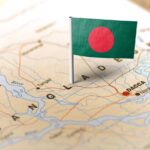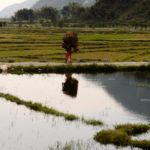Envisioning Nepal 2030 is a long-term development strategy for Nepal developed in 2016, with the help of the Asian Development Bank (ADB). The strategy is made with recommendations from academics, scholars, and development practitioners. The development strategy aims to progress Nepal and graduate from least developed country (LDC) status by 2022 and achieve Sustainable Development Goals (SDGs) along with becoming a middle-income country by 2030. The foundations of Envisioning Nepal 2030 are built on the following pillars.
Figure 1: Pillars of Envisioning Nepal 2030
Source: Envisioning Nepal 2030, International Seminar Proceedings Report
As part of the 15-year development strategy, Nepal is halfway there and, in this article, progress made so far as per the development strategy has been mapped out along with an understanding of the challenges and opportunities that follow it.
Key Targets of Envisioning Nepal 2030
The Envisioning Nepal 2030 aims to fulfill the following key targets by 2030:
- Graduation of LDC status by 2022: During the publication of the development strategy, Nepal was classified under the LDC by the United Nations (UN). To graduate from the LDC, Nepal needs to meet several criteria which included increasing the per capita income, reducing the poverty rate, and improving the human development index.
- Achieve the SDGs by 2030: The SDGs consist of 17 goals adopted by the UN to serve as a shared blueprint for the prosperity of the people and the planet. The SGD goals consist of goals like no poverty, ending hunger, good health, quality education, and 13 more goals. Nepal is committed to achieving the SDG Goals by 2030.
- Becoming a Middle-income Country by 2030: The World Bank categorizes countries having Gross National Income (GNI) per capita between USD 1,036 and USD 12,535 as middle-income countries. To fulfill the target of becoming a middle-income country, Nepal needs to continue to grow its economy and improve its standard of living.
Progress of Envisioning Nepal 2030
Mapping through the progress made in fulfilling the development strategy goals, Nepal is recommended for graduation from the LDC to Developing Country by the United Nations. The country has requested five years to prepare for graduation, which means Nepal will graduate from LDC by 2026. A country can graduate from the LDC category by meeting two of the three criteria. The criteria include income, human assets, and economic and environmental vulnerability. A country can further graduate by having a per-capita income of more than twice the income generation threshold, at two consecutive triennial meetings at the UN Committee of Development Policy. Nepal achieved the graduation threshold by the country’s achievement in Human Assets (HAI) and Economic Vulnerability (EVI) index. Nepal has a HAI score of 74.9 (66 or above for graduation) and EVI score of 24.7 (32 or below for graduation). Though graduation is not happening in 2022 as previously targeted, the country will graduate before the end of the development strategy in 2030.
Nepal has made significant strides in fulfilling the SDGs as well. The National Review 2020 of Nepal conducted by the UN indicates that the poverty rate has been reduced from 22.7% in 2014 to 15.1% in 2023 on track to fulfill SDG Goal 1. Nepal has also achieved the gender parity index on track to fulfilling SDG Goal 5. In the case of climate change, Nepal is a leading example of good afforestation programs supported by community forestry. Under community-based forest management, the forest coverage has reached 42.7% outperforming the target of 39.8%.
The next point of progress towards Envisioning Nepal’s 2030 development strategy is Nepal reaching the middle-income status. Nepal made the jump to a middle-income country in 2019 when the GNI per capita rose to USD 1,090 which is above the threshold of USD 1,036; from USD 960 in 2018. COVID-19 was predicted to falter Nepal’s status as a middle-income country but the recent projections made by the National Planning Commission (NPC) the GNI is expected to increase to USD 1,434 in FY 2022/23, USD 1,572 in FY 2023/24, USD 1,740 in FY 2024/25 and USD 1,935 by 2025/26.
Challenges of Meeting the Development Strategy Targets
The major challenge Nepal faces to complete the development strategy is maintaining the progress made by that strategy. Nepal has faced multiple pitfalls in recent years like the COVID-19 pandemic and the indirect effects of the Russia-Ukraine conflict which can undo the achievements Nepal has made. The average annual growth rate of Nepal targeted by the development strategy is 7%, while the growth rate is expected to be around 4.4% for the FY 2023/24, due to the damage caused by the global lockdown.
The role of good governance, one of the pillars of Envisioning Nepal 2030, needs to be strong to complete the development strategy on time. The frequent changes in the government do not help in setting goals and clear targets to achieve all the prerequisites for the 2030 deadline. Adding to the point, accountability by the government is important for building up the citizens as well. The poverty rate target set by the strategy is less than 10%, while the current poverty rate stands at 15.1% (FY2022/23). We are a long way from reaching the target. To achieve the target, proper goal setting and transparency from the government along with making a clear plan is the main challenge of completing development strategy.
Are We On Track?
There is a positive outlook for Nepal to reach the set targets outlined in Envisioning Nepal 2030. Approximately two-thirds of the goals are either completed or on track. Nepal has achieved the status of a middle-income country and is working towards graduating from the least developed country category. Some of the SDG goals that Nepal set out to complete by 2023 have been achieved, such as reducing the poverty rate below the 16% threshold, achieving SDG Goal 5 by maintaining progress in gender parity, and exceeding the targets for forest coverage. However, meaningful results for the remaining goals are yet to be seen.
To meet the requirements of achieving the SDGs, concerted efforts need to be devised. While some goals may currently seem out of reach for completion by 2030, measures can be implemented to bring them back on track. It is important to make efforts, update plans and policies, and engage all stakeholders to ensure the success of Envisioning Nepal 2030. For this, the foundation of good governance, economic transformation, social development, environmental sustainability, and good governance should be strictly observed with the support of the government and the involvement of all stakeholders. Nepal has a good chance of graduating from its current status, unless there are unforeseen circumstances such as conflicts or global crises like the COVID-19 pandemic that may pose challenges to achieving the development strategy goals.
Adarsha Subedi is an Economics undergraduate currently enrolled at Kathmandu University School of Arts. He has a keen interest in international, development economics, public policy, and economic theory. He is an intern at NEF.






